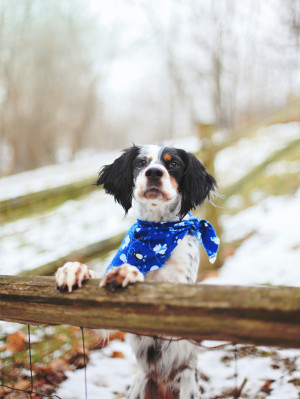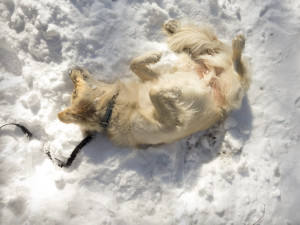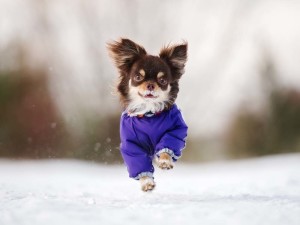7 Ways to Keep Your Pup Cozy on Snowy Days
A professional dog walker’s pro tips for making winter your dog’s favorite time of year.

share article

Your pet wants you to read our newsletter. (Then give them a treat.)
Being a dog parent is a full time job — the best job ever, sure, but one with zero vacation days. Like the USPS, we take a vow to carry out our duties come rain, snow, or the gloom of night. That’s why when winter comes around, there’s usually a little panic bubbling under the relief of cozy-sweater-and-apple-cider season; whether we and our pups like it or not, we’re gonna have to spend a lot of time outside together. It’s in the job description (and we’re paid in unconditional love, so we can’t really complain).
Most of us are used to bundling ourselves up to face the elements, but it can be a little harder to tell what our dogs need — and they rely on us to figure it out, ‘cause they can’t shop for booties themselves. Here are some tips for keeping your pup safe, warm, and happy in frigid temperatures.
1. Know your dog’s tolerance for cold.
Each dog has a different threshold for cold tolerance, which is greatly dependent on the dog’s breed. Hardy, double-coated breeds, such as Newfoundlands and Huskies, are pretty well prepared for cold weather and can handle longer outings in harsher conditions.
Short-haired or slick-coated dogs like Greyhounds, Weimaraners or Pugs may not find the outdoors as enticing, so bundle them upopens in a new tab as needed, and keep a careful eye for signs of chill (shivering, whining, excessive paw-lickingopens in a new tab, holding paws off the ground, or tail-tucking). If you see any of those signs, it’s time to go back inside. Next time, consider adding a layer, or even doggy bootiesopens in a new tab.
When it comes to comfortable temperatures for dogs, there’s no one-size-fits-all answer. A lot depends on a dog’s age, size, coat type, and individual preference. But generally, most healthy adult dogs are okay until temperatures fall below 45°F. At that point, some dogs may become uncomfortable. Below 32°F, small-breed dogs, dogs with thin coats, and very young or very old dogs will be negatively affected by the cold. At 20°F and below, any dog is in danger of developing cold-associated and potentially fatal conditions like hypothermia or frostbite. Wind, dampness and other climatological factors also affect how a dog experiences cold, so keep an eye on your pup and follow your instincts if they seem chilly.
2. Stock up on long-lasting chews and puzzle toys.
Winter always includes a smattering of brutal storms that put a halt to all driving and outdoor activities. Make sure to have your dog’s favorite chews or puzzle toysopens in a new tab on hand to give them something to do on days you need to stay in. Chewing relieves stress and puzzle toys expend mental energy, which help keep your dog from bouncing off the walls while you work from home, take care of the family, or just relax.
3. Maintain and check your equipment regularly.
If your equipment is going to fail, it’s likely to happen in the cold weather. Keep your leather goods (leashes, harnesses, collars) from cracking or splitting with regular cleaning and conditioning. Store metal pieces (such as safety clips or leash snaps) indoors to prevent them from sticking open or closed, and wipe them clean and dry after use.
4. Wax those paws pre-walk.
Hate the snowballs that pile up on your dog’s paws after a romp in the frosty woods? Your dog does, too. Smear a thin coat of paw waxopens in a new tab on your pup’s pads before heading outside and the snow won’t stick. That means no painful ice clumps between your dog’s toes and no snowballs melting all over the house after your walk. Paw wax also prevents pads from cracking and becoming sore on even the driest of days.
5. Hydrate, hydrate, hydrate!
Offer your dog plenty of water before, during, and after excursions to keep them hydrated in the dry winter air and to minimize self-hydrating with snow. Eating snow in small amounts is no big deal, but in larger quantities it can be unsafe, as the snow may be polluted by antifreezeopens in a new tab, non-pet-safe ice melt, or other harmful contaminants. Nix excessive snow-eating by always having fresh water on hand and offering it to your dog frequently.
6. Feed as required, not as routine.
A majority of dogs get less exercise during the winter. The less you walk your dog, the fewer calories your dog will burn and the less food they will need to maintain a healthy weight. On the flip side, if you’re maintaining the same exercise routine, or have a hardy dog who spends more time outdoors, they will burn more calories in the cold and deep snow and may need more food in their bowl. Regularly assess even the fluffiest of pooches for weight gain or loss, and adjust feedings as necessary.
Another feeding tip: Keeping your dog’s coat in top-top shape (a good move any time of the year) can make a real difference to their comfort level in the winter. Vet Deva Khalsa recommends adding oil — either olive or coconut — to dogs’ food as a healthy fix for winter dandruff and dry-skin problems. As she points out, “Supporting your dog’s biological terrain is the single most important way to maintain his well being and help him have healthy skin and a great coat. Both olive and coconut oil are healthy for your dog’s insides, and it will show on his outside.”
7. Exercise and train inside on truly cold days.
Frigid temperatures plus wet conditions is a recipe for frostbite and chills. On the coldest of cold weather days, it’s best to opt for short potty walks and indoor exercise. This is a great time to sign up for a Zoom dog-training class, teach the pup that party trick you’ve been dying to get just right, or fine-tune your obedience skill set. If you and your dog are sick of training at home, take a trip to a local dog-friendly store for a change of scenery.
For working breeds like Belgian Malinois, Border Collie or, really, any energetic dog, a treadmill can be a true lifesaver during inclement weather. Consult a trainer before attempting to teach your dog to exercise on a treadmill, and always stay with them when they’re using it.
Aileen Whitty
Aileen Whitty , Wag & Whinny, LLC; serving pets and people of the New Hampshire/Maine Seacoast area.
Related articles
![Arisa, a woman with long curly hair wearing bright blue pants and a pink short-sleeve t-shirt sitting in a wicker chair holding her Dachshund dog, Lola, and her cat, Nipsey, laying on top of the chair cage]() opens in a new tab
opens in a new tabArisa Thomas’ Guide to Cozying Up With Your Pet This Chilly Season
The mega-stylish dog groomer’s top picks for autumn and winter dog products.
![Sam Klein with her pets]() opens in a new tab
opens in a new tabSam Klein’s Holiday Gift Guide For Dog Parents
The interior designer merges her love of design and dogs with these holiday gift picks.
![Happy Chihuahua dog running outdoors wearing blue jacket in winter snow]() opens in a new tab
opens in a new tab23 Winter Trappings for the Dog With Outdoorsy Parents
Ski-club balaclavas, waterproof wellies, all-natural nose balm, and more gear to help outdoorsy pet parents get the most out of the season.
![dog using diy paw wax to protect paws in snow standing next to fence]() opens in a new tab
opens in a new tabCold Weather Is the Nemesis of Dog Paws. Here’s How to Help
We all have to up our moisturizing game in the fall and winter.





